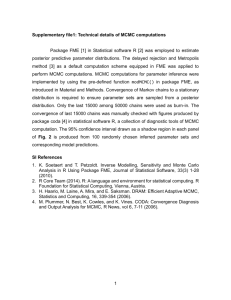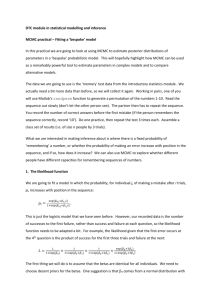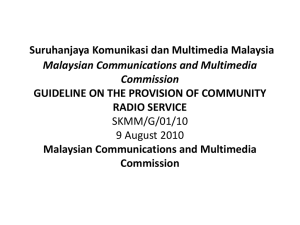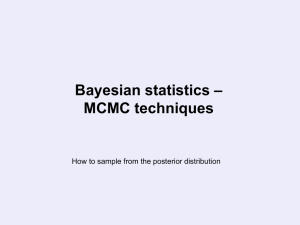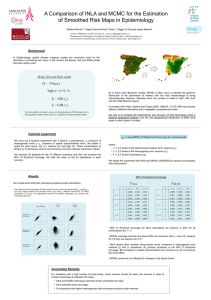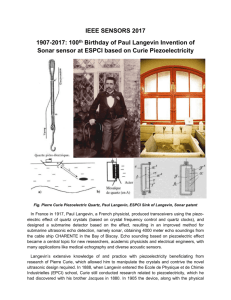slides - University of Oxford
advertisement
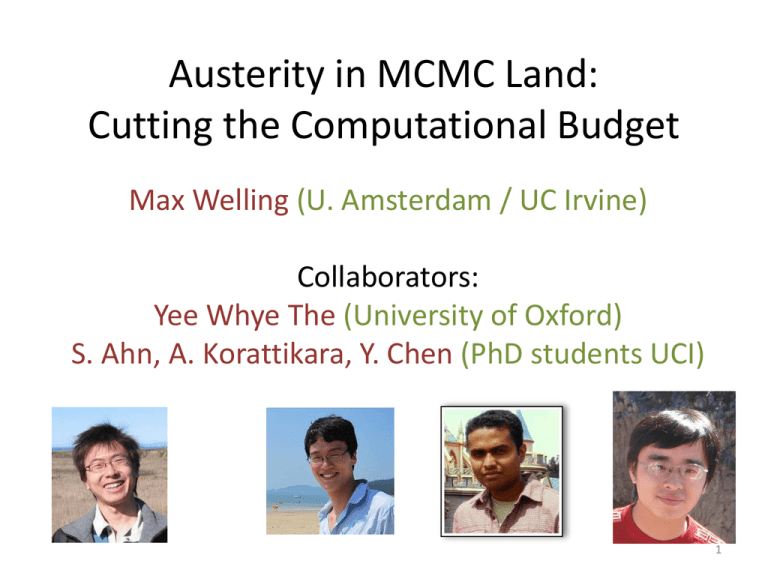
Austerity in MCMC Land: Cutting the Computational Budget Max Welling (U. Amsterdam / UC Irvine) Collaborators: Yee Whye The (University of Oxford) S. Ahn, A. Korattikara, Y. Chen (PhD students UCI) 1 2 Why be a Big Bayesian? ? • If there is so much data any, why bother being Bayesian? • Answer 1: If you don’t have to worry about over-fitting, your model is likely too small. • Answer 2: Big Data may mean big D instead of big N. • Answer 3: Not every variable may be able to use all the data-items to reduce their uncertainty. 3 ! Bayesian Modeling • Bayes rule allows us to express the posterior over parameters in terms of the prior and likelihood terms: 4 MCMC for Posterior Inference • Predictions can be approximated by performing a Monte Carlo average: 5 Mini-Tutorial MCMC Following example copied from: An Introduction to MCMC for Machine Learning Andrieu, de Freitas, Doucet, Jordan, Machine Learning, 2003 6 Example copied from: An Introduction to MCMC for Machine Learning Andrieu, de Freitas, Doucet, Jordan, Machine Learning, 2003 7 8 Examples of MCMC in CS/Eng. Image Segmentation Image Segmentation by Data-Driven MCMC Tu & Zhu, TPAMI, 2002 Simultaneous Localization and Mapping Simulation by Dieter Fox 9 MCMC • We can generate a correlated sequence of samples that has the posterior as its equilibrium distribution. Painful when N=1,000,000,000 10 What are we doing (wrong)? At every iteration, we compute 1 billion (N) real numbers to make a single binary decision…. 1 billion real numbers (N log-likelihoods) 1 bit (accept or reject sample) 11 Can we do better? • Observation 1: In the context of Big Data, stochastic gradient descent can make fairly good decisions before MCMC has made a single move. • Observation 2: We don’t think very much about errors caused by sampling from the wrong distribution (bias) and errors caused by randomness (variance). • We think “asymptotically”: reduce bias to zero in burn-in phase, then start sampling to reduce variance. • For Big Data we don’t have that luxury: time is finite and computation on a budget. bias variance computation 12 Error dominated by bias Markov Chain Convergence Error dominated by variance 13 The MCMC tradeoff • You have T units of computation to achieve the lowest possible error. • Your MCMC procedure has a knob to create bias in return for “computation” Turn left: Slow: small bias, high variance Claim: the optimal setting depends on T! Turn right: Fast: strong bias low variance 14 Two Ways to turn a Knob • Accept a proposal with a given confidence: easy proposals now require far fewer data-items for a decision. • Knob = Confidence [Korattikara et al, ICML 1023 (under review)] • Langevin dynamics based on stochastic gradients: ignore MH step • Knob = Stepsize [W. & Teh, ICML 2011; Ahn, et al, ICML 2012] 15 Metropolis Hastings on a Budget Standard MH rule. Accept if: • Frame as statistical test: given n<N data-items, can we confidently conclude: ? 16 MH as a Statistical Test • Construct a t-statistic using using a random draw of n data-cases out of N data-cases, without replacement. Correction factor for no replacement reject proposal accept proposal collect more data 17 Sequential Hypothesis Tests reject proposal accept proposal collect more data • Our algorithm draws more data (w/o/ replacement) until a decision is made. • When n=N the test is equivalent to the standard MH test (decision is forced). • The procedure is related to “Pocock Sequential Design”. • We can bound the error in the equilibrium distribution because we control the error in the transition probability . • Easy decisions (e.g. during burn-in) can now be made very fast. 18 Tradeoff Percentage data used Percentage wrong decisions Allowed uncertainty to make decision 19 Logistic Regression on MNIST 20 Two Ways to turn a Knob • Accept a proposal with a given confidence: easy proposals now require far fewer data-items for a decision. • Knob = Confidence [Korattikara et al, ICML 1023 (under review)] • Langevin dynamics based on stochastic gradients: ignore MH step • Knob = Stepsize [W. & Teh, ICML 2011; Ahn, et al, ICML 2012] 21 Stochastic Gradient Descent Not painful when N=1,000,000,000 • Due to redundancy in data, this method learns a good model long before it has seen all the data 22 Langevin Dynamics • Add Gaussian noise to gradient ascent with the right variance. • This will sample from the posterior if the stepsize goes to 0. • One can add a accept/reject step and use larger stepsizes. • One step of Hamiltonian Monte Carlo MCMC. 23 Langevin Dynamics with Stochastic Gradients • Combine SGD with Langevin dynamics. • No accept/reject rule, but decreasing stepsize instead. • In the limit this non-homogenous Markov chain converges to the correct posterior • But: mixing will slow down as the stepsize decreases… 24 Stochastic Gradient Langevin Dynamics Gradient Ascent Langevin Dynamics ↓ Metropolis-Hastings Accept Step Stochastic Gradient Ascent e.g. Stochastic Gradient Langevin Dynamics Metropolis-Hastings Accept Step 25 A Closer Look … large 26 A Closer Look … small 27 Example: MoG 28 Mixing Issues • Gradient is large in high curvature direction, however we need large variance in the direction of low curvature slow convergence & mixing. We need a preconditioning matrix C. • For large N we know from Bayesian CLT that posterior is normal (if conditions apply). Can we exploit this to sample approximately with large stepsizes? 29 The Bernstein-von Mises Theorem (Bayesian CLT) “True” Parameter Fisher Information at ϴ0 Fisher Information 30 Sampling Accuracy– Mixing Rate Tradeoff Mixing Rate Sampling Accuracy Stochastic Gradient Langevin Dynamics with Preconditioning Samples from the correct posterior, , at low ϵ Mixing Rate Sampling Accuracy Markov Chain for Approximate Gaussian Posterior Samples from approximate posterior, , at any ϵ 31 A Hybrid Small ϵ Mixing Rate Sampling Accuracy Large ϵ 32 Experiments (LR on MNIST) No additional noise was added (all noise comes from subsampling data) Batchsize = 300 Ground truth (HMC) Diagonal approximation of Fisher Information (approximation would become better is we decrease stepize and added noise) 33 Experiments (LR on MINIST) X-axis: mixing rate per unit of computation = Inverse of total auto-correlation time times wallclock time per it. Y-axis: Error after T units of computation. Every marker is a different value stepsize, alpha etc. Slope down: Faster mixing still decreases error: variance reduction. Slope up: Faster mixing increases error: Error floor (bias) has been reached. 34 SGFS in a Nutshell 35 Conclusions • Bayesian methods need to be scaled to Big Data problems. • MCMC for Bayesian posterior inference can be much more efficient if we allow to sample with asymptotically biased procedures. • Future research: optimal policy for dialing down bias over time. • Approximate MH – MCMC performs sequential tests to accept or reject. • SGLD/SGFS perform updates at the cost of O(100) data-points per iteration.
